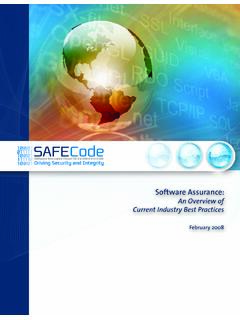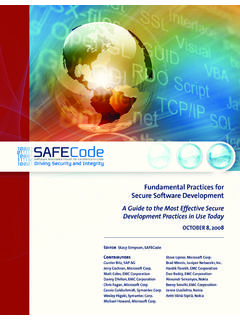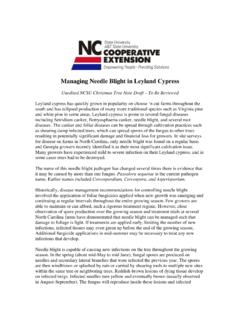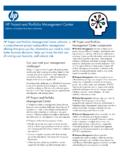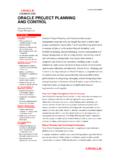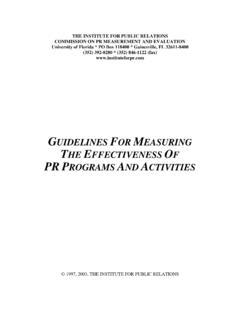Transcription of Managing Security Risks Inherent in the Use of …
1 2017 SAFECode All Rights Reserved. Managing Security Risks Inherent in the Use of Third-party Components Managing Security Risks Inherent in the Use of Third-party Components 2017 SAFECode All Rights Reserved. 2 Table of Contents 1 Introduction .. 4 Methodology and Scope .. 4 2 Challenges in Using Third-party Components .. 5 Example Use Case .. 5 What TPCs Are Included in a Product? .. 6 Naming of Components .. 7 Dependencies .. 7 Is the Product Affected by the Vulnerable Third-party Component? .. 8 Naming of Components .. 9 Dependencies .. 9 CVE Reports .. 9 What TPCs Should We Use and What Are the Security Risks Associated with Them? .. 9 What Should We Do To Maintain the TPCs Within Our Product? .. 10 3 Managing Third-party Components .. 11 Overview of the Third-party Component Management Life Cycle .. 11 TPC Life Cycle and Software Development Life Cycle.
2 12 Key Ingredients of a TPC Management Process .. 14 Maintain List of TPCs (MAINTAIN) .. 15 Assess Security Risk (ASSESS) .. 19 Mitigate or Accept Risk (MITIGATE) .. 22 Monitor for TPC Changes (MONITOR) .. 23 Closing the Example Use Case .. 25 Selecting TPCs .. 25 Monitoring TPCs .. 25 Responding to New 25 Maintaining the TPCs in the Product .. 26 4 Future Considerations .. 27 Crowdsourcing of Naming and Name Mapping .. 27 Crowdsourcing of an End-of-life Repository .. 27 Crowdsourcing of a Vulnerability Source Listing .. 27 5 Summary .. 28 28 Managing Security Risks Inherent in the Use of Third-party Components 2017 SAFECode All Rights Reserved. 3 Contributors .. 28 Reviewers .. 28 About SAFECode .. 29 6 Appendix .. 30 TPC Provider s Security Mindedness/Posture Assessment .. 30 Related Work .. 30 Identification of Third-party Components and Dependency Management.
3 30 Vulnerability Databases .. 31 Managing Security Risks Inherent in the Use of Third-party Components 2017 SAFECode All Rights Reserved. 4 1 Introduction Usage of third-party components (TPCs) has become the de-facto standard in software development. These TPCs include both open-source software (OSS) and commercial off-the-shelf (COTS) components. According to a survey by Black Duck software1, 78 percent of respondents said their companies run part or all of its operations on OSS and 66 percent said their company creates software for customers built on open-source. This statistic has nearly doubled since 2010 [..]. TPCs, used as pre-made building blocks, enable faster time to market and lower development costs by providing out-of-the box functionality of common functions, allowing developers to focus on product-specific customizations and features. While these TPCs are often treated as black boxes and are less scrutinized than comparable internally developed components, they are not without risk.
4 Users inherit the Security vulnerabilities of the components they incorporate. Historically, the selection and usage of TPCs has been an engineering decision, purely based on functionality. Given the increasing trend in usage of third-party components, Security must be a consideration in the selection and usage of TPCs2. The number of vulnerabilities reported against TPCs, both OSS and proprietary COTS software, should serve as a strong testament that Managing Security Risks due to the use of third-party components is an important duty for their users. Some good examples include Heartbleed (CVE-2014-01603), which was disclosed in 2014, and more recently, a Security flaw in the GNU C Library (CVE-2015-75474) that was discovered by researchers in 2015. These vulnerabilities triggered analysis and remediation activities on an unprecedented scale that sent the software industry into a patching frenzy.
5 To attackers, the fact that TPCs are widely used in software development is an introduction and invitation to an unexplored land of opportunities. The current state of uncontrolled TPC usage must be replaced by a disciplined analysis and consideration of Security risk. Disclaimer: This white paper focuses only on Security Risks Inherent in the use of third-party components. Any other Risks such as legal or regulatory Risks , intellectual property, business Risks , OSS vs. COTS quality or due diligence are out of scope for this white paper. Methodology and Scope The supply chain of components in software development is extremely varied and complex. There are many different use cases and considerations for TPCs, and there are several open-source and commercial tools offering capabilities to assist with the management of TPCs (see section ). This white paper is the culmination of a yearlong research project within SAFECode that included surveys and industry research to identify best practices in TPC management.
6 At the time of this research, no single body of work comprehensively addressed the issues with the usage of TPCs in product development. This white paper provides a blueprint for how to identify, assess and manage the Security Risks associated with the use of third-party components. The white paper helps to understand these Security Risks and 1 2 3 4 Managing Security Risks Inherent in the Use of Third-party Components 2017 SAFECode All Rights Reserved. 5 provides recommendations to help manage them. Through this white paper, SAFECode aims to share our collective knowledge regarding the challenges and recommended solutions for dealing with TPCs. The SAFECode publication Principles for Software Assurance Assessment 5 more broadly addresses software Security assurance of commercial technology providers and thus includes use cases that are different from the one in this white paper.
7 The table below summarizes these use cases, clarifying which paper covers which use case. Use Case Publication An organization is evaluating/acquiring COTS software applications to install/use within a corporate network or environment. This is often done through a procurement process. Principles for Software Assurance Assessment 5 An organization is evaluating/acquiring open-source software applications to install/use within a corporate network. This is often done through a procurement process. An Assurance-Based Approach to Minimizing Risks in the Software Supply Chain 6 A development team in an organization is selecting or using open-source or COTS components for inclusion in products. This white paper An organization is contracting out custom development of a component or product. Not in scope For trainings on this and other topics, please refer to 2 Challenges in Using Third-party Components This section introduces the importance of a well-established third-party component management life cycle by taking an example use case from the life of Bob, a software developer.
8 This example use case highlights challenges faced by Bob in the absence of a TPC management life cycle which are discussed further in the rest of this section. Recommended solutions for Managing third-party components that address these challenges are discussed in section 3. Example Use Case Bob s team is developing a product that incorporates a variety of third-party components (TPCs) to provide functionality the product needs. Bob s company does not have any requirements or restrictions on using third-party components. The integration of TPCs is quickly completed and the product is released and sold to customers. Not long after the production release, the internet is abuzz with reports of a new critical Security vulnerability. The vulnerability was discovered in an open-source component and has 5 6 Managing Security Risks Inherent in the Use of Third-party Components 2017 SAFECode All Rights Reserved.
9 6 been assigned an official Common Vulnerabilities and Exposures (CVE) number by the MITRE Corporation7. Bob s teammate Juanita forwards the CVE to Bob and asks him whether his product is affected. Bob encounters his first problem: What third-party components are included in my product? Bob mines his product documentation and code to attempt to determine what TPCs are included/used in the product. After much effort, a list of TPCs is generated. Now Bob encounters his next problem: Is the product affected by the CVE? The CVE lists the affected component as Strawberry Lane version Bob s list of components does not contain Strawberry Lane version but it does include StrwLn version Bob wonders whether this is the same component. He does additional research and determines that it is, in fact, the same component, despite the different name. Bob must also evaluate whether or not the product uses the specific TPC functionality that is vulnerable.
10 After extensive design and code reviews, Bob determines that the product is affected. While Bob is evaluating the impact of the vulnerability, the product is compromised by attackers who succeed in accessing the data stored in the database server. Root cause analysis points to a serious vulnerability in a different TPC that has been known publicly for many years. Fixing these issues while in production results in financial loss, service outage, reputational exposure and decrease in customers' faith. Bob's company is responsible for any vulnerabilities in the product even though the vulnerability is in a third-party component and not the custom code that Bob added. Bob s team struggles with the question, What should we do to maintain the TPCs within our product? The Quality Assurance & Product Security Incident Response teams at Bob's company insist on a full bill of materials (BOM) to identify all TPCs in the product and to make sure that other components are not vulnerable.
